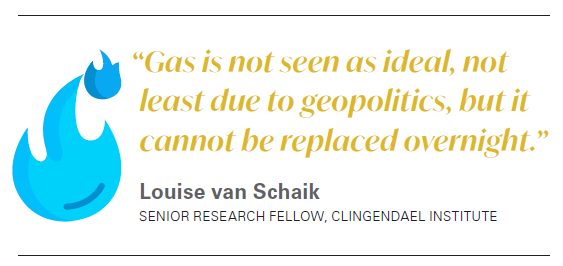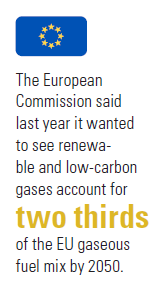Gas set for inclusion in EU Taxonomy, but conditions apply [Gas in Transition]
The European Commission (EC) in January formally proposed to classify gas and nuclear power as sustainable investments under the Taxonomy Regulation and the EU’s European Parliament and Council now have a maximum of six months to decide whether to support this proposal. The proposal under the so-called Delegated Act, which would be annexed to the Taxonomy Regulation adopted in 2020, has been labelled as “greenwashing” by some, but the inclusion of natural gas power plants is subject to a set of strict conditions. For example, direct greenhouse gas (GHG) emissions from new gas-fired power plants must be lower than 270 g of CO2e/kWh and must replace more polluting installations such as coal-fired plants. There must also be plans in place to co-fire natural gas with renewable or low-carbon gases, with a blending rate of at least 30% clean gases by 2026, 55% by 2030 and a full switch to clean gases by 2035.
This is no mean feat. Modern combined cycle gas turbines (CCGTs) emit around 340g of CO2e/kWh without abatement from carbon capture technologies or the co-firing with, for example, with blue or green hydrogen. For combined heat and power (CHP) plants, the best-in-class technology is currently at around 270 g of CO2/kWh or roughly around the threshold set by the EC. But even new CHP plants will need to prepare for 30% co-firing by 2026. This raises technological challenges and costs concerns, and also the question of whether there will be enough volumes of cleaner and renewable gases available to support co-firing by the middle of the decade. 
The Taxonomy Regulation is not a binding piece of legislation as such, but rather a ‘rulebook’ for which investments that can be labelled sustainable. With pressure mounting on companies to expand their ‘green’ asset base and reduce exposure to fossil fuel projects, being taxonomy compliant seems key to attract finance and design business models that are fit for the future.
"The taxonomy regulation will have a huge impact. Investments classified as sustainable will get easier access to financing including cheaper loans. There will also be pressure on companies from NGOs to adhere to the taxonomy,” Louise van Schaik, head of unit and senior research fellow at the Clingendael Institute in the Hague tells NGW.
“There is also the Brussels effect of legislation going beyond the borders of the EU - the taxonomy standards are likely to be followed in other parts of the world," she says.
To this end, the EU Taxonomy Regulation is being closely observed around the world. The South Korean environment ministry said in January that it would continue to monitor the EU's taxonomy negotiations and closely review its standards. South Korea has developed its own taxonomy standards, the so-called K-Taxonomy announced in late December 2021. The K-Taxonomy classifies new LNG power plants as sustainable if emitting less than 340 g of CO2e/kWh and if there are plans to achieve average lifespan emissions of 250 g CO2e/kWh in the mid- to long-term. New nuclear power plants are not included in the K-Taxonomy.
Key vote in June
Back in Europe, all eyes are now on the parliament and council which will either adopt or reject the Delegated Act tabled by the EC. The council will have the right to object to it by so-called reverse reinforced qualified majority which means a majority from at least 20 member states representing at least 65% of the EU population. The European Parliament will need at least 353 MEPs – out of 705 MEPs in the plenary – to vote against the Delegated Act to see it rejected. Both institutions will have four months to scrutinise the Delegated Act before casting a vote, but may ask for two months more which would drag out the process until mid-June.
The member states, represented by the ministers in the EU council, have diverging views on the inclusion of gas and nuclear in the Taxonomy Regulation. Germany, which is phasing out its last nuclear power plants this year, has traditionally been opposed to the inclusion of nuclear power. As for gas, the new coalition government led by Chancellor Olaf Scholz of the Social Democratic Party, sees the blue fuel as a pragmatic solution in a transition period, to support intermittent supply from wind and solar. The Greens, which is part of the government coalition, are more opposed to nuclear and coal, which in terms of CO2 is far more polluting than gas.
"In Germany, the Greens are in principle against gas, but they have realised that a transition fuel is needed. The Delegated Act also highlights that natural gas is a transitional fuel that will gradually be replaced by renewable energy," van Schaik says.
The French have lobbied for the inclusion of nuclear power in the taxonomy, which is unsurprising given the country’s large nuclear fleet and continued investment in new reactors. A requirement for nuclear power under the Delegated Act is that there is a plan in place to deal with the waste, van Schaik notes. She expects the Delegated Act to be supported by the parliament and the council in the end.
"The EU considers nuclear power climate friendly, but not environmentally friendly. But CO2 reductions take preference over concerns related to radioactive waste etc. Gas is not seen as ideal, not least due to geopolitics, but it cannot be replaced overnight," said van Schaik.
Mounting pressure to decarbonise gas
Although gas is tipped to continue playing a major role in Europe’s power mix for many years to come, EU legislation will add pressure to decarbonise the sector either through abatement technologies or blending with cleaner gases. One example of this is the revised Trans-European network for Energy (TEN-E) Regulation. The EC first tabled a proposal for a revised TEN-E Regulation in 2020 as the rules adopted in 2013 are seen as outdated. In mid-December 2021, the parliament and the council reached an agreement in principle on the revised regulation.
TEN-E encompasses Projects of Common Interest (PCI) which is a selection of energy projects eligible for fast-track regulatory approval and potential access to EU funding under the Connecting Europe Facility (CEF). The PCI list is updated every two years and a number of gas projects with PCI status have received grants under CEF in the past including Croatia’s Krk terminal which received over €124mn ($142mn).
Under the revised TEN-E Regulation, fossil projects including natural gas pipelines will no longer be eligible for funding under CEF. However, an exception will be made for blending projects during a transitional period that will end in 2029. The new rules will apply from the sixth PCI list which is expected to be published in the autumn of 2023. Formal adoption of the revised TEN-E Regulation is expected later this year.
The council and parliament’s compromise text noted that blending of hydrogen with natural gas or biomethane could play a role in scaling up hydrogen production capacity and facilitating transport of hydrogen. But the text underscores that blending should only be an option in an interim period.
“To ensure the transition, the project promoter should demonstrate including through commercial contracts how, by the end of this transitional period, the natural gas assets will become dedicated hydrogen assets, as well as the increased use of hydrogen enabled during the transitional period,” the text said.
For projects receiving funding under CEF, there should be a condition obliging repayment of the grant should there be doubt of the “timely transition of the project to a dedicated hydrogen asset,” according to the text.
Another key development is the revised EU State Aid guidelines which will make it harder for EU member states to get EC approvals for national grants to gas-fired power and gas-fired industrial projects.
Under the revised guidelines, which will be adopted this month, member states must explain how they will ensure that a natural gas investment contributes to achieving the EU’s 2030 target of 40% GHG emissions reductions and the 2050 climate neutrality target.
“In particular, the member states must explain how a lock-in of this gas-fired energy generation or gas-fired production equipment will be avoided,” say the new guidelines.



